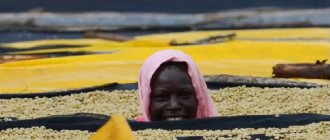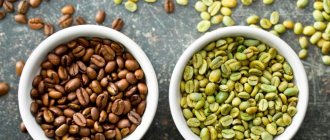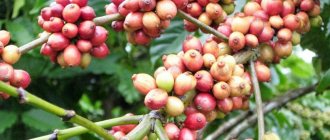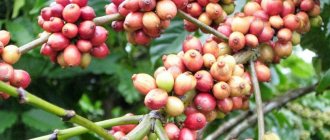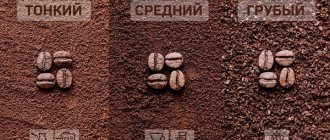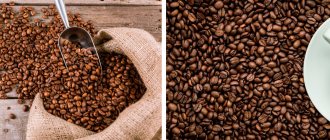Our experts have prepared useful tips for you to help you make the right choice when buying ground coffee.
Coffee is one of the most refined drinks that is present in almost every home. Ground coffee has a special status. This is what all gourmets choose in order to experience the true taste of this drink, as well as feel the desired effect. Choosing ground coffee is an art that requires special knowledge. Many people can rely on the seller in this matter, however, this is a big mistake. Most often, the seller himself is not aware of the varieties and features, but is simply trying to sell you what is beneficial to him. That's why we've prepared 9 expert tips to help you make the right choice among the wide variety of ground coffee in our catalogue.
So what is the strongest coffee?
It turns out that strength is a combination of two factors: a rich taste with a pleasant bitterness and a high caffeine content. There is a drink that fully corresponds to these two characteristics, it is called Cold Brew.
The preparation method is that the ground coffee is poured with cold water and infused for 8 to 24 hours, as a result of which the taste of the drink is very rich, with a pronounced bitterness, a medium density body and a high caffeine content.
Different understandings of the term “strong” encourage baristas to experiment, trying to satisfy the taste needs of every coffee lover.
A table indicating the degree of richness of the taste of the drink on a 10-point scale:
| 1 | 2 | 3 | 4 | 5 | 6 | 7 | 8 | 9 | 10 | |
| Ristretto | + | + | + | + | + | + | + | + | + | + |
| Espresso | + | + | + | + | + | + | + | + | + | |
| Lungo | + | + | + | + | + | + | + | + | ||
| Americano | + | + | + | + | + | + | ||||
| Filter coffee | + | + | + | + | + | |||||
| Cold Brew | + | + | + | + | + | + | + | + | ||
| Cappuccino | + | + | + | |||||||
| Latte | + | |||||||||
| Flat White | + | + | + | + | + | + |
How to correctly evaluate strength
To determine the strength of coffee, you need to observe the subtleties of tasting, because the manufacturer may not provide detailed information on the packaging. For this procedure you will need:
- measuring container;
- coffee cups;
- teaspoons;
- water;
- boiling water.
The grains must be ground immediately before cooking. You need to brew medium-ground grains. For 2 tsp. you will need 100-120 ml of water. After brewing, wait for some of the coffee grounds to sink to the bottom of the cup. And the remaining part will harden into a “crust”.
The drink is allowed to brew, then the film is “broken” with a spoon and the aroma is inhaled. Then they begin to evaluate the taste and aftertaste. If you are tasting several types of coffee, baristas are advised to drink water.
The acidity of the drink is also assessed - how rich it is. High-quality coffee has a balanced aroma and taste. The concentrated drink is consumed in small portions to enjoy it without harming your health. Excessive use may cause addiction. In addition to its tonic effect, caffeine puts increased stress on the cardiovascular system.
Tip #6. We distinguish between types of packaging
Inside the roasted beans there is a special gas bubble, which stores the entire aroma of this drink. After grinding, the coffee begins to “fizzle out,” which leads to a complete loss of aroma. To avoid this consequence, buy coffee in a vacuum briquette. It will best preserve the aroma of your drink and will also prevent it from spilling. Never buy coffee in paper bags that sit in the store for a long time. If you have your eye on coffee by weight, which is sold exclusively in paper bags, then ask to grind it in front of you to be sure of its freshness and aroma. When you get home, don’t forget to pour it into a jar or vacuum briquette, which you set aside specifically for your favorite drink and do not use for other purposes.
Production nuances and more
Ground coffee is sometimes supplied with aromatic “decor”. It is worth remembering that strong vanilla, orange or wine aroma shades are often of “chemical” origin. The most unscrupulous manufacturers can mix ground powder with very unappetizing ingredients - starch, clay, crushed date seeds, chicory and even the possible presence of an additive, pour a pinch of powder onto a white paper sheet and carefully examine its structure. “Multi-colored” particles indicate the presence of impurities. You can determine their presence in another way: pour a pinch of coffee powder into a bowl of cool water. The stuck together impurities will soon “settle” at the bottom and color the water. About a fifth of the assortment of all coffee shops is decaffeinated. You can recognize it by the label Decaf / Decaffeinato / Decaffeinated. In terms of taste, high-quality decaf is no different from regular coffee, but it is much less invigorating. An indicator of the quality of instant coffee is the dissolution speed: in cool water - about 3 minutes, in hot water - no more than 30 seconds.
The soluble powder, “convenient” for brewing, loses most of its useful compounds during the production process, incl. caffeine. The exception is freeze-dried coffee made at “negative” temperatures. It retains up to 3% caffeine. However, superior flavor characteristics are often achieved by “artificial” flavoring.
Arabica or Robusta
All varieties of coffee are produced from two coffee trees - Arabica or Robusta, the choice of which is determined solely by personal preference. Arabica is more capricious to grow, has elongated grains, a noble, slightly sweet and rich taste, in which a piquant mixture of bitterness and sourness is felt. Robusta does not require special conditions during the growing process, easily tolerates the vagaries of weather and temperature changes, has round grains, and is characterized by a high caffeine content and a bitter taste. Very often, manufacturers mix Robusta with Arabica, but the best coffee varieties are 100% Arabica, although Arabica grown in different countries or even on neighboring plantations can vary greatly in taste and aroma. Brazilian Arabica has a slight nutty flavor, Indian Arabica is famous for its chocolate tones, Kenyan gives a slight winey sourness, and in Ethiopian Arabica you can feel berry notes if desired.
Explore the packaging
Made in Russia, Germany, Italy. Could this be possible? After all, as you know, coffee does not grow in Russia. And in Germany it’s hard to imagine sprawling coffee plantations. So what's the deal? It's actually simple. Coffee beans are purchased from Brazil, Colombia, Kenya or India. And already at their factories, manufacturers roast, grind coffee, and package it.
Good ground coffee is packaged only in glass or tin containers . Cheaper varieties and coarsely ground coffee are packaged in vacuum plastic bags, which must have a valve. This hole is the size of a small pea. Many buyers mistakenly think that it is left on purpose so that they can appreciate the aroma of coffee. But this is not entirely true - gases that are released during coffee storage and which can swell the soft packaging escape through this hole.
Tip #1. Choosing a manufacturer
There is an opinion that it is necessary to buy ground coffee exclusively from Brazil, Colombia or India, since that is where the huge plantations of our element are located. But you should not make a choice in favor of these countries. Countries such as Italy, Germany and others buy coffee from the above countries, and only then apply certain roasting and grinding methods to them. Moreover, the technologies of these countries are more progressive, so we can say that the final product is better. That is why it is better to give preference to progressive countries in which the necessary fruits do not grow, but coffee is produced under a well-known brand, than to “coffee” countries that do not have the proper technologies and brand.
Extraction time
Extraction is the release of flavoring substances through a solvent, in the case of coffee, water. And the extraction time is the period during which the ground coffee comes into contact with water. The smaller the grind, the faster the extraction occurs.
Espresso is extracted on average 25 seconds, and coffee brewed in a Turk, with the same grinding - from 5-6 minutes (200 ml). The taste of the drink will be less dense and concentrated than espresso, but more invigorating. The amount of caffeine in the drink depends on the extraction time: the longer the coffee is in contact with water, the more caffeine it will contain. A rich and bright taste does not always indicate more caffeine, take, for example, coffee brewed in a French press. This type of coffee requires a coarser grind than espresso and a longer extraction time of 4 to 5 minutes. The taste of the drink will be softer, the body will be watery, but despite this, the caffeine content in it will be higher than in espresso.
The intensity and amount of caffeine in the drink can be adjusted. One way is to increase the brew time. The second way is to increase the portion of coffee.
Tip #4. Pay attention to the type of coffee
Of course, there are an indefinite number of varieties. They all have their own special taste, which, basically, can only be recognized by a true gourmet or a person with good taste buds. However, all these varieties come down to two, which are considered classic - Arabica and Robusta. You can often find the words “100% Arabica” on packaging. Its meaning is clear, but how does it affect the taste of the drink?
Arabica has a slight acidity, rich taste and strong aroma. It has less caffeine than Robusta. The Robusta variety has a stronger taste, instead of sourness there are bitter notes, and it also contains more caffeine. You can rarely find “100% Robusta” coffee on the shelves, since it is used to dilute Arabica beans. Thus, we get a mixture for the espresso drink. Pay attention to the percentage ratio of these two varieties on the packaging to understand what kind of drink you can prepare.
Additional information: what should you pay attention to?
We have listed the criteria by which you can determine which coffee is best for you. But there are a couple more nuances.
With or without caffeine? If there are contraindications, it is advisable to choose decaffeinated mixtures.
Flavored or unflavored? Often, coffee does not contain various additives; special notes are revealed thanks to the masterly mixing of several varieties by blending masters.
Buying ground coffee
When purchasing a crushed product, you need to pay attention to the packaging, which has the same requirements as in the case of the grain version, and pay attention to the degree of grinding.
Table 1. Degrees of grinding of coffee beans
| Grinding | Grinding time in an electric coffee grinder | Brewing device |
| Rude | 7 seconds | Drip coffee maker, French press |
| Average | 12 seconds | Geyser coffee maker, Aeropress, Turk |
| Thin | 20 seconds | Coffee maker with filter, Turk |
| Small | 25 seconds | Turk |
| Espresso grind | About 30 seconds | Espresso coffee machine, carob coffee maker |
| Ultra-thin | Professional equipment | Turk |
It is worth considering that the grinding time depends on the power of the equipment. Ultra-fine grinding is produced by professional-class machines. For brewing in Turk, the finest grind is considered optimal.
When purchasing ground coffee, the risk of purchasing a low-quality product increases. Storage periods are even more limited. In crushed form, the loss of aromatic compounds occurs faster. The introduction of artificial flavoring additives cannot be ruled out.
You can determine the quality of ground coffee by examining the composition on a white sheet of paper for foreign inclusions and pouring a pinch of the mixture into cold water. Good coffee does not color the liquid and does not settle to the bottom.
Information on how to choose the right natural coffee beans based on packaging will allow you to purchase a quality product. Coffee quickly loses its taste if not stored correctly, so packaging is of particular importance.
For packaging coffee beans use:
- paper bags;
- plastic bags;
- foil bags;
- sealed bags with valve;
- aluminum cans.
Products made from paper and polyethylene are not suitable for long-term storage, due to their inability to maintain the quality of coffee. Paper bags do not retain essential oils, and plastic bags prevent the release of fumes after frying and allow light to pass through, which deteriorates the properties of the product.
Grain packaging must provide protection from moisture, foreign odors, and microbial spoilage. Roasted fruits emit gas, an excess of which causes the packets to burst open until their integrity is damaged. Therefore, packages are equipped with valves that remove gases and prevent air from entering the package.
Premium coffee is packaged in aluminum cans. In addition to the aesthetic side, the rigid frame provides protection from mechanical damage.
Variety
Let us roughly divide the varieties of ground coffee by country of cultivation:
India – high strength, hints of spice.
Ethiopia – slightly perceptible berry and fruit notes.
Brazil – medium strength, chocolate aftertaste.
Kenya - a delicious fruit and berry bouquet.
Guatemala – chocolate tones, long aftertaste.
Colombia – characteristic sweetness, nutty notes.
Yemen is an ensemble of wine, berry, fruit, chocolate shades.
Jamaica has an incredibly soft taste, complemented by delicate sourness.
Cuba – high strength with notes of pepper.

